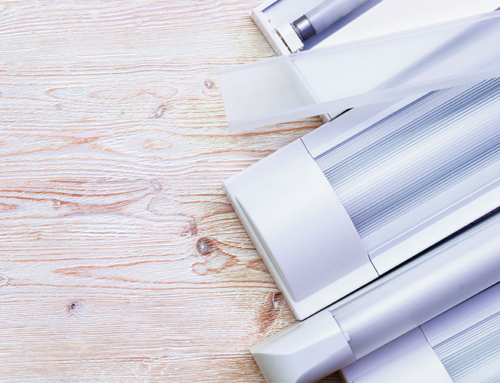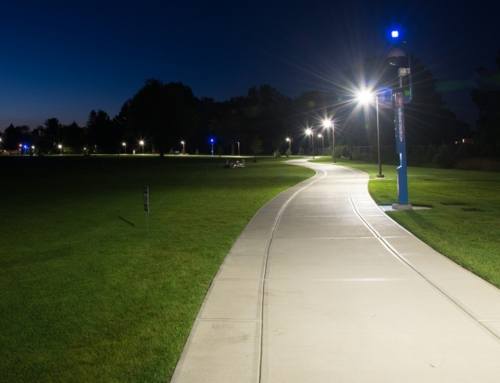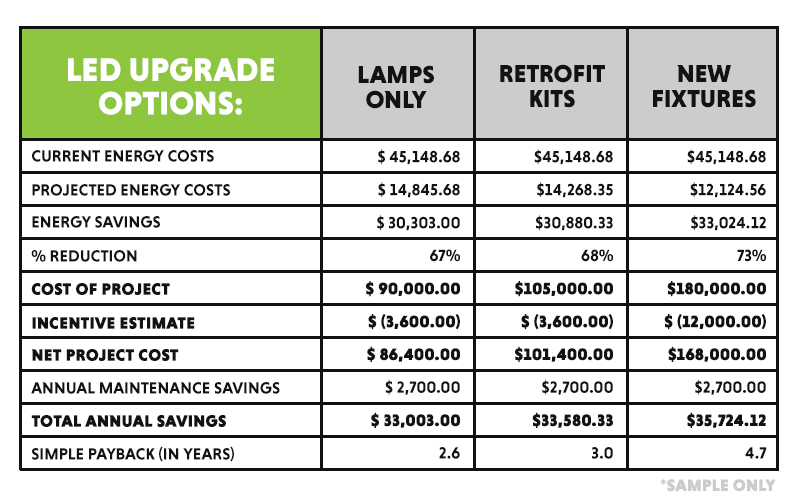
Troffer fixtures have been in the crosshairs ever since LEDs became cost-effective enough to replace fluorescent lighting technology. The recessed troffers—1×4, 2×2, and 2×4’s—in our ceilings have been ripe for an efficiency upgrade for nearly a decade. With the menu of energy efficient upgrades better than ever, building owners and facilities managers have an amazing opportunity to improve their energy efficiency.
The key to a successful lighting upgrade is to assess your existing facility needs, evaluate the available upgrade options, and testing a few fixtures before committing.
Fluorescent to LED Upgrade Options
Three options exist for upgrading the lighting of a commercial building from fluorescent to LED: T8 LED (TLED) lamp-only swaps, LED retrofit kits, and entirely new fixtures. There is no straightforward answer as to which solution is superior because each option has pros and cons. The best choice will depend on project-specific conditions and the goals of your upgrade—let’s compare the advantages and disadvantages of all three:
Option #1: Lamp-Only Upgrades
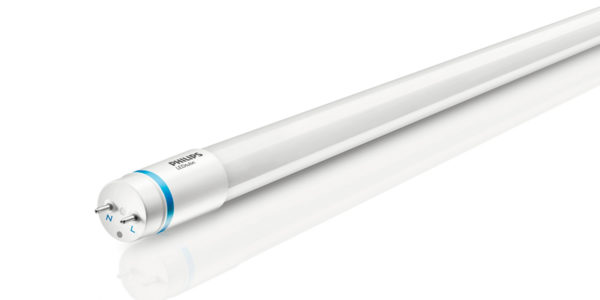
This solution involves purchasing T8 LED lamps that are designed to work with your existing fixtures. There are three different types of LED lamp-only upgrades available—UL Type A, UL Type B, and UL Type C. Depending on which UL Type is selected, ballasts and lamp holders may need to be replaced or bypassed.
UL Type A works with an existing fluorescent ballast. Compatibility issues may arise between the new lamp and the current ballast, even between lamps and ballasts from the same manufacturer. Reviewing the manufacturer’s list of compatible ballasts is recommended before committing. If the ballast is older than 10 years, consider replacing it as well, as it has less compatibility with new technology.
UL Type B—also known as “Ballast Bypass Lamps” or “Direct Wire Lamps”—bypass the existing ballast and are wired directly to main voltage. These lamps require re-wiring of the fixture and will most-likely require new lamp holders.
UL Type C is similar to Type A lamps, but utilize a new driver, rather than a ballast. Type C TLEDs have the longest lifespan and offer dimming capabilities, but also have the highest price.
Advantages of Lamp-Only Upgrades:
- Cheapest Upfront Cost
- Quickest Installation
- Fixture and All Optical Components Remain
- Energy Savings—40%-60%
Disadvantages of Lamp-Only Upgrades:
- Performance Depends on Existing Fixture/Ballast
- May Not be Compatible w/ Controls
- Possible electrocution, flicker and surge protection issues (w/ UL Type B)
When a Lamp-Only Upgrade Makes Sense:
Upgrading only the lamps from fluorescent to LED is recommended when your budget is limited or when the project must be completed with minimal downtime—the two main selling points of a “lamp-only” upgrade are a lower price and how simple installation can be.
Things to Consider With Lamp-Only Upgrades:
It’s worth pointing out that the cost difference between LED T8 lamps, LED retrofit kits, and new fixtures is inching closer and closer together. While this may be the least expensive solution upfront, there are compromises in terms of performance and energy savings, including dimming capabilities—if lighting controls are part of your energy management plan, swapping only the lamp may not be the way to go.
Light output should also be considered as TLEDs do not distribute omnidirectional light like T8 fluorescents. While they may generate similar light levels per lamp, they aren’t optimizing the optics of the existing troffers.
Finally, make sure your fixtures are compatible with the new LED T8s you’re installing (many are, but some won’t be) and that the lamp fits properly into the existing troffer. There are many small variables—such as the size of the sockets—that can cause installation to go from easy to impossible.
Option #2: LED Retrofit Kits
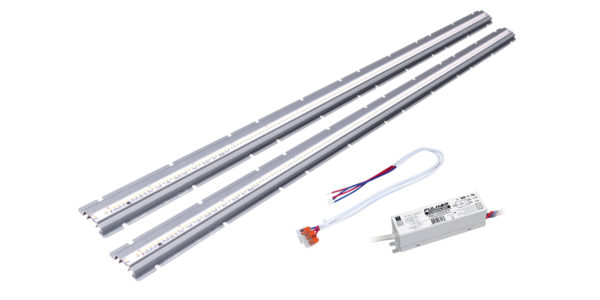
An LED retrofit kit replaces all the components of the existing troffer except the “shell” above the ceiling. The new components fit inside the shell of the old troffer and make it look like a brand new fixture.
LED retrofit kits are a popular option because they’re less expensive upfront than new fixtures, can deliver greater energy savings than TLEDs, and offer several performance upgrades over TLED lamp swaps.
Advantages of LED Retrofit Kits:
- Lower Upfront Cost vs New Fixture
- Keeps the Existing Fixture Housing Installed
- Longer-Term Option vs Lamps-Only
- Potential Dimming and Control Capabilities
- Energy Savings—50%-70%
Disadvantages of LED Retrofit Kits:
- Higher Upfront Costs vs Lamps-Only
- Longer Installation Time (depending on condition of fixtures)
When an LED Retrofit Upgrade Makes Sense:
LED retrofit kits are similar in simplicity to LED replacement lamp options, but provide more performance opportunities particularly regarding lighting controls. As long as the existing fixture is in decent shape, using a commercial retrofit kit is a great solution to upgrade your lighting system.
Option #3: New Fixtures Designed with LEDs

This solution involves completely removing the existing troffer fixture and replacing it with an LED fixture. LED fixtures are distinct for having light engines—an LED chip (or array of LED chips) mounted on a circuit board instead of the traditional lamp concept. One beneficial aspect of new fixtures is that you can specify lumen packages, color temperatures and CRI levels as needed for your facility.
Troffer prices vary depending on lumen output requirements, brand, aesthetics, lighting controls/dimming needs, and a host of other factors. So, depending on your performance and aesthetic requirements, you could find that the cost difference between a new 2×4 troffer and a retrofit kit is either $10 or $100, depending on your specific scenario.
Advantages of New Fixtures:
- Dimming, Occupancy Sensing, and Daylight Harvesting Controllability
- Energy Savings—50%-70%
Disadvantages of New Fixtures:
- Highest Upfront Investment (material + labor)
- Longer Installation Time
When New Fixtures Make Sense:
There are two ideal scenarios where the installation of new LED fixtures is recommended:
- Metal Halide or T5 high bay lighting, corrosive environments, exterior lighting or performance (sports complex) lighting.
- New construction; if it’s necessary to purchase new light fixtures, purchase the most-efficient and longest-lasting option on the market.
Things to Consider with New Fixture Upgrades:
The biggest performance incentive of installing new fixtures is that the components of the fixture are built for LED versus a combination of fluorescent components and LED technology. You can look at delivered lumens and photometric charts and feel confident that what you see is what you get.
So Which Option is Best?
Like many investment decisions, choosing the right upgrade option comes down to cost and benefits. We’re big fans of LED retrofit upgrades. That said, every project and budget is different, and each option has a list of pros and cons. Sometimes the goal of a lighting project is optimal performance, sometimes it’s about a cost-effective solution, and sometimes there’s room for both.
Have Questions?
Want to know more? Schedule a consultation with an EPL team member to receive our professional lighting guidance at no cost!


